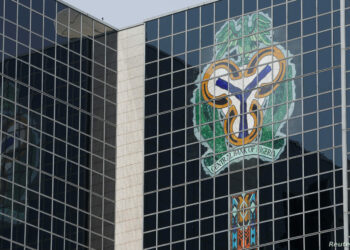Nigeria’s Tier-2 banks are embarking on an unprecedented capital-raising drive as the March 2026 deadline set by the Central Bank of Nigeria (CBN) for recapitalisation draws closer. With the regulator mandating new capital thresholds of N500 billion for international banks, N200 billion for national banks, and N50 billion for regional players, mid-tier lenders face a defining test that could reshape the country’s banking landscape.
The recapitalisation exercise, reminiscent of the consolidation reforms of 2004–2005, is forcing banks to explore multiple avenues to strengthen their balance sheets. For Tier-2 institutions like FCMB, Fidelity, Sterling, Wema, and Stanbic IBTC, the next 18 months will determine their survival, growth trajectory, and relevance in a market increasingly dominated by Tier-1 giants such as Zenith, Access, and FBN Holdings.
The urgency of recapitalisation is underscored by the dominance of Tier-1 banks. In 2024, Zenith Bank posted an 86 per cent year-on-year surge in gross earnings to N3.97 trillion and a 67 per cent rise in profit before tax to N1.3 trillion. Similar stellar performances from Access Bank and FBN Holdings highlight the widening gulf between Nigeria’s largest lenders and their mid-tier counterparts.
As SBM Intelligence observes in its latest report, “The Nigerian banking sector stands at a pivotal crossroads, shaped by a confluence of robust Tier-1 bank performance, sweeping regulatory reforms, and mounting pressures for industry-wide recapitalisation.”
First City Monument Bank (FCMB) has unveiled a three-pronged strategy to raise approximately N400 billion. The first phase, a public offer concluded in early 2025, raised N144.6 billion and was oversubscribed by 33 per cent. The bank has also launched a convertible note issuance, expected to generate between N20 and N40 billion by the third quarter of 2025.
In subsequent phases, FCMB plans to divest minority stakes in subsidiaries, Credit Direct Limited and FCMB Pensions Limited, through an IPO and private placements targeting up to N90 billion. The final tranche will involve offshore development finance institutions via preference shares or additional public offers to secure the balance of N170 billion.
According to SBM, “This approach is designed to minimise earnings dilution and maintain investor confidence,” providing FCMB with a steady path to compliance. Already, FCMB’s share price has risen from N3.33 in 2020 to N9.25 by mid-2025, reflecting renewed investor sentiment.
Fidelity Bank has emerged as a frontrunner in the recapitalisation race. Through a combined public offer and rights issue, it raised more than N270 billion, with oversubscriptions of 238 per cent and 138 per cent respectively. The bank has received shareholder approval to increase its issued share capital from N26.7 billion to N36.7 billion, creating an additional 20 billion ordinary shares. Fidelity’s next phase will seek to push its capital above the N500 billion threshold, firmly placing it among international banks.
SBM highlighted the pace of Fidelity’s efforts, noting that “the bank has made rapid progress in its recapitalisation journey, prioritising early completion ahead of the 2026 regulatory deadline.” The market has responded positively. Fidelity’s share price surged from N1.65 in 2020 to N21.20 by mid-2025, an extraordinary 1,100 per cent growth in five years.
Sterling Financial Holdings Company is pursuing a combination of private placements, rights issues, and public offers to meet its target of $400 million (about N400 billion). The initial private placement in 2024 attracted strong investor interest, while a rights issue allowed existing shareholders to increase their stakes. A forthcoming public offer is expected to complete the capital raising, consolidating Sterling’s efforts to meet regulatory thresholds.
SBM notes that Sterling’s phased approach reflects a “multi-stage recapitalisation plan, leveraging shareholder loyalty and strategic investor interest.” This has positioned the bank to remain competitive in the rapidly changing environment.
Wema Bank has adopted a two-tranche plan involving rights issues and private placements. A N40 billion rights issue completed in December 2023 laid the foundation, followed by a N150 billion rights issue launched in April 2025. In May, shareholders approved a N50 billion private placement targeting institutional investors. This strategy is expected to push Wema’s total capital raised to over N200 billion, positioning it for compliance with the CBN directive.
The bank’s digital transformation, anchored on its ALAT platform, has strengthened customer acquisition and revenue generation. “Wema’s transformation was driven by its pioneering digital banking initiatives and a proactive approach to recapitalisation, which resonated with both retail and institutional investors,” the report stated. Wema’s share price has climbed from N1.50 in 2020 to nearly N15.00 in 2025, further boosting investor confidence.
Stanbic IBTC Holdings has also taken significant steps, raising N148.7 billion through a rights issue that was oversubscribed by nearly 22 per cent. The bank is well on its way to meeting the recapitalisation requirement and remains a strong contender in the mid-tier space.
The recapitalisation drive is forcing Nigerian banks to innovate and consolidate. Analysts expect a wave of mergers and strategic alliances among Tier-2 banks seeking to scale up. The focus, however, extends beyond compliance.
As SBM puts it, “The regulatory call to action is not merely a compliance exercise; it is a strategic imperative designed to fortify the sector’s capacity to withstand macroeconomic shocks, support Nigeria’s ambition for a $1 trillion economy, and restore global investor confidence.”
While Fidelity and Wema have gained remarkable investor traction, FCMB and Sterling are adopting phased strategies, and Stanbic IBTC is leveraging its strong balance sheet. Each path highlights the adaptability of mid-tier banks in navigating regulatory headwinds. SBM stresses that “understanding how these banks are navigating the dual pressures of market competition and regulatory reform will provide valuable insights into their resilience, strategic agility, and long-term viability.”
With the March 2026 deadline looming, the race among Tier-2 banks is intensifying. Those unable to raise sufficient capital risk being acquired or reclassified. Consolidation, while disruptive, could create stronger, more competitive institutions capable of financing Nigeria’s economic growth.
For customers and employees, the changes may bring both opportunities and challenges. Larger, better-capitalised banks are expected to expand credit access and introduce innovative financial products. However, smaller banks struggling to meet thresholds may face staff layoffs, branch rationalisation, or loss of market identity.
Nigeria’s Tier-2 banks are at a critical juncture, as their ability to execute bold recapitalisation strategies, sustain profitability, and embrace digital innovation will shape their place in the evolving financial sector. To SBM, “The ongoing recapitalisation drive is set to reshape the competitive landscape, enhancing the stability of the banking system and positioning Nigerian banks to support the country’s ambition for a $1 trillion economy.”





